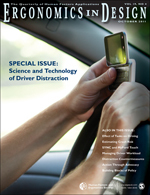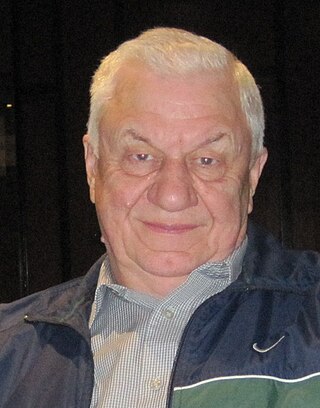
Driving simulators are used for entertainment as well as in training of driver's education courses taught in educational institutions and private businesses. They are also used for research purposes in the area of human factors and medical research, to monitor driver behavior, performance, and attention and in the car industry to design and evaluate new vehicles or new advanced driver assistance systems.
The Chartered Institute of Ergonomics and Human Factors is a United Kingdom-based professional society for ergonomists, human factors specialists, and those involved in user-centred design.
Vision science is the scientific study of visual perception. Researchers in vision science can be called vision scientists, especially if their research spans some of the science's many disciplines.
Situational awareness or situation awareness (SA), that is, understanding an environment, its elements, and how it changes with respect to a time vector or other factors, is critical for appropriate and optimized decision making in many environments. It is formally defined as:
“the perception of the elements in the environment within a volume of time and space, the comprehension of their meaning, and the projection of their status in the near future”.
Cognitive ergonomics is a scientific discipline that studies, evaluates, and designs tasks, jobs, products, environments and systems and how they interact with humans and their cognitive abilities. It is defined by the International Ergonomics Association as "concerned with mental processes, such as perception, memory, reasoning, and motor response, as they affect interactions among humans and other elements of a system. Cognitive ergonomics is responsible for how work is done in the mind, meaning, the quality of work is dependent on the persons understanding of situations. Situations could include the goals, means, and constraints of work. The relevant topics include mental workload, decision-making, skilled performance, human-computer interaction, human reliability, work stress and training as these may relate to human-system design." Cognitive ergonomics studies cognition in work and operational settings, in order to optimize human well-being and system performance. It is a subset of the larger field of human factors and ergonomics.
Industrial ergonomics programs seek to identify and correct factors that negatively impact the physical health of their workers. Participatory ergonomics programs seek to maximize the involvement of the workers in this process based on the simple fact that a worker is an expert on his or her job. The participatory approach to ergonomics relies on actively involving workers in implementing ergonomic knowledge, procedures and changes with the intention of improving working conditions, safety, productivity, quality, morale and/or comfort.
ViEWER, the Virtual Environment Workbench for Education and Research, is a proprietary, freeware computer program for Microsoft Windows written by researchers at the University of Idaho for the study of visual perception and complex immersive three-dimensional environments.
The Human Factors and Ergonomics Society (HFES) is an interdisciplinary nonprofit professional organization, headquartered in Washington, D.C., within the so-called Potomac Chapter of the organization. Founded in 1957, HFES now claims 4500 members worldwide. HFES has 67 active chapters throughout the United States, Canada, and Europe; 42 of these are student chapters, and 23 are technical groups.
The NASA Task Load Index (NASA-TLX) is a widely used, subjective, multidimensional assessment tool that rates perceived workload in order to assess a task, system, or team's effectiveness or other aspects of performance. It was developed by the Human Performance Group at NASA's Ames Research Center over a three-year development cycle that included more than 40 laboratory simulations. It has been cited in over 4,400 studies, highlighting the influence the NASA-TLX has had in human factors research. It has been used in a variety of domains, including aviation, healthcare and other complex socio-technical domains.
Interruption science is the interdisciplinary scientific study concerned with how interruptions affect human performance, and the development of interventions to ameliorate the disruption caused by interruptions. Interruption science is a branch of human factors psychology and emerged from human–computer interaction and cognitive psychology.

Ergonomics in Design: The Quarterly of Human Factors Applications is a quarterly peer-reviewed academic journal that covers research in the field of ergonomics. The editor-in-chief is Rammohan V. Maikala. It was established in 1993 and is currently published by SAGE Publications in association with the Human Factors and Ergonomics Society.

The Journal of Cognitive Engineering and Decision Making is a quarterly peer-reviewed academic journal that covers research on human cognition and the application of this to the design and development of system interfaces and automation. Its editor-in-chief is Jan Maarten Schraagen. It was established in 2007 and is currently published by SAGE Publications in association with the Human Factors and Ergonomics Society.

Human factors and ergonomics is the application of psychological and physiological principles to the engineering and design of products, processes, and systems. Primary goals of human factors engineering are to reduce human error, increase productivity and system availability, and enhance safety, health and comfort with a specific focus on the interaction between the human and equipment.
David Shinar is one of the most prominent and productive researchers in the area of traffic safety, and a professor emeritus at Ben-Gurion University of the Negev, Israel.
The International Conference on Applied Human Factors and Ergonomics (AHFE) is an academic multi-conference that includes several affiliated conferences, jointly held under one management and one registration. The conference provides an international forum for the exchange of scientific information on theoretical, generic, and applied areas of ergonomics, including physical ergonomics, cognitive and neuroergonomics, social and occupational ergonomics, affective and pleasurable design, and systems engineering. The conference includes keynote presentations, parallel sessions, poster sessions, tutorials, exhibits, and special interest meetings. Submissions are peer-reviewed and published in the conference proceedings; select papers are also expanded and published in AHFE Edited Conference Books.
Human performance modeling (HPM) is a method of quantifying human behavior, cognition, and processes. It is a tool used by human factors researchers and practitioners for both the analysis of human function and for the development of systems designed for optimal user experience and interaction. It is a complementary approach to other usability testing methods for evaluating the impact of interface features on operator performance.

Katherine Vera Aumer is an American social psychologist. Her current research focuses on interpersonal relationships and identity issues concerning both culture and race. Her work has also focused on the psychology of hatred. Formerly an associate professor and chair of psychology at Hawaii Pacific University, she currently serves as an assistant professor of psychology at the University of Hawaiʻi – West Oʻahu.

The Institute of Industrial and Systems Engineers (IISE), formerly the Institute of Industrial Engineers, is a professional society dedicated solely to the support of the industrial engineering profession and individuals involved with improving quality and productivity.

This page was translated from the Russian version of the article

Barrier pointing is a term used in human–computer interaction to describe a design technique in which targets are placed on the peripheral borders of touchscreen interfaces to aid in motor control. Where targets are placed alongside raised edges on mobile devices, the user has a physical barrier to aid navigation, useful for situational impairments such as walking; similarly, screen edges that stop the cursor mean that targets placed along screen edges require less precise movements to select. This allows the most common or important functions to be placed on the edge of a user interface, while other functions that may require more precision can utilise the interface's 'open space'.







